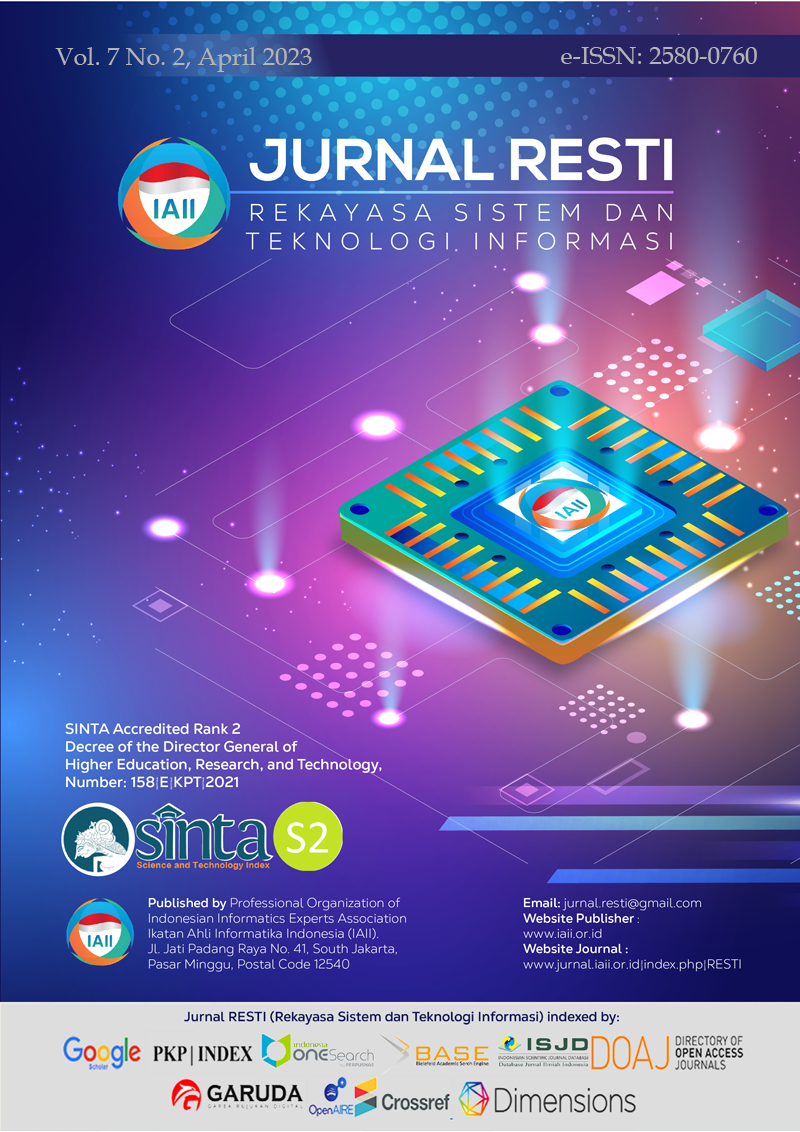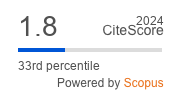A Hybrid Method on Emotion Detection for Indonesian Tweets of COVID-19
Abstract
As a result of the COVID-19 pandemic, there have been restrictions on activities outside the home which has caused people to interact more and express their emotions through social media platforms, one of which is Twitter. Previous studies on emotion classification used only one feature extraction, namely the lexicon based or word embedding. Feature extraction using the emotion lexicon has the advantage of recognizing emotional words in a sentence while feature extraction using word embedding has the advantage of recognizing the semantic meaning. Therefore, the main contribution to this research is to use two lexicon feature extraction and word embedding to classify emotions. The classification technique used in this research is the Ensemble Voting Classifier by selecting the two best classifiers to try on both types of feature extraction. The experimental results for both types of feature extraction are the same, indicating that the best classifiers are Random Forest and SVM. Models using both types of feature extraction show increased accuracy compared to using only one feature extraction. The results of this emotional analysis can be used to determine the public's reaction to an event, product, or public policy.
Downloads
References
J. Abdillah, I. Asror, and Y. F. A. Wibowo, “Emotion Classification of Song Lyrics using Bidirectional LSTM Method with GloVe Word Representation Weighting,” J. RESTI Rekayasa Sist. Dan Teknol. Inf., vol. 4, no. 4, pp. 723–729, Aug. 2020, doi: 10.29207/resti.v4i4.2156.
F. Keshtkar and D. Inkpen, “A Hierarchical Approach to Mood Classification in Blogs,” Nat. Lang. Eng., vol. 18, no. 1, pp. 61–81, Jan. 2012, doi: 10.1017/S1351324911000118.
D. Purwitasari, A. Apriantoni, and A. B. Raharjo, “Identifikasi Pengaruh Pandemi Covid-19 terhadap Perilaku Pengguna Twitter dengan Pendekatan Social Network Analysis,” J. Teknol. Inf. Dan Ilmu Komput., vol. 8, no. 6, p. 1309, Nov. 2021, doi: 10.25126/jtiik.2021865213.
T. T. Sasidhar, P. B, and S. K. P, “Emotion Detection in Hinglish (Hindi+English) Code-Mixed Social Media Text,” Procedia Comput. Sci., vol. 171, pp. 1346–1352, 2020, doi: 10.1016/j.procs.2020.04.144.
N. Shelke, S. Chaudhury, S. Chakrabarti, S. L. Bangare, G. Yogapriya, and P. Pandey, “An efficient way of text-based emotion analysis from social media using LRA-DNN,” Neurosci. Inform., vol. 2, no. 3, p. 100048, Sep. 2022, doi: 10.1016/j.neuri.2022.100048.
S. H. Sahir, R. S. Ayu Ramadhana, M. F. Romadhon Marpaung, S. R. Munthe, and R. Watrianthos, “Online learning sentiment analysis during the covid-19 Indonesia pandemic using twitter data,” IOP Conf Ser Mater Sci Eng, vol. 1156, no. 1, p. 012011, 2021, doi: 10.1088/1757-899x/1156/1/012011.
H. Aka Uymaz and S. Kumova Metin, “Vector Based Sentiment and Emotion Analysis from Text: A survey,” Eng. Appl. Artif. Intell., vol. 113, p. 104922, Aug. 2022, doi: 10.1016/j.engappai.2022.104922.
Rahman, Romana, Islam, Tajul, and Ahmed, Md. Humayan, “Detecting Emotion from Text and Emoticon,” Lond. J. Res. Comput. Sci. Technol., vol. 17, no. 3, pp. 9–13, 2017.
A. Bandhakavi, N. Wiratunga, S. Massie, and D. Padmanabhan, “Lexicon Generation for Emotion Detection from Text,” IEEE Intell. Syst., vol. 32, no. 1, pp. 102–108, Jan. 2017, doi: 10.1109/MIS.2017.22.
Md. Y. Kabir and S. Madria, “EMOCOV: Machine Learning for Emotion Detection, Analysis and Visualization Using COVID-19 Tweets,” Online Soc. Netw. Media, vol. 23, p. 100135, May 2021, doi: 10.1016/j.osnem.2021.100135.
D. yasmina, M. Hajar, and A. M. Hassan, “Using YouTube Comments for Text-based Emotion Recognition,” Procedia Comput. Sci., vol. 83, pp. 292–299, 2016, doi: 10.1016/j.procs.2016.04.128.
Samsir, Ambiyar, U. Verawardina, F. Edi, and R. Watrianthos, “Analisis Sentimen Pembelajaran Daring Pada Twitter di Masa Pandemi COVID-19,” JURNAL MEDIA INFORMATIKA BUDIDARMAJURNAL MEDIA INFORMATIKA BUDIDARMA, vol. 5, no. 10, pp. 174–179, 2021, doi: 10.30865/mib.v4i4.2293.
A. R. Murthy and K. M. Anil Kumar, “A Review of Different Approaches for Detecting Emotion from Text,” IOP Conf. Ser. Mater. Sci. Eng., vol. 1110, no. 1, p. 012009, Mar. 2021, doi: 10.1088/1757-899X/1110/1/012009.
H. Tian and L. Wu, “Microblog Emotional Analysis Based on TF-IWF Weighted Word2vec Model,” in 2018 IEEE 9th International Conference on Software Engineering and Service Science (ICSESS), Beijing, China, Nov. 2018, pp. 893–896. doi: 10.1109/ICSESS.2018.8663837.
Siti Khomsah, Rima Dias Ramadhani, and Sena Wijaya, “The Accuracy Comparison Between Word2Vec and FastText On Sentiment Analysis of Hotel Reviews,” J. RESTI Rekayasa Sist. Dan Teknol. Inf., vol. 6, no. 3, pp. 352–358, Jun. 2022, doi: 10.29207/resti.v6i3.3711.
F. Incitti, F. Urli, and L. Snidaro, “Beyond Word Embeddings: A survey,” Inf. Fusion, vol. 89, pp. 418–436, Jan. 2023, doi: 10.1016/j.inffus.2022.08.024.
M. Giatsoglou, M. G. Vozalis, K. Diamantaras, A. Vakali, G. Sarigiannidis, and K. Ch. Chatzisavvas, “Sentiment Analysis Leveraging Emotions and Word Embeddings,” Expert Syst. Appl., vol. 69, pp. 214–224, Mar. 2017, doi: 10.1016/j.eswa.2016.10.043.
S. Muñoz and C. A. Iglesias, “A Text Classification Approach to Detect Psychological Stress Combining a Lexicon-Based Feature Framework with Distributional Representations,” Inf. Process. Manag., vol. 59, no. 5, p. 103011, Sep. 2022, doi: 10.1016/j.ipm.2022.103011.
N. Aliyah Salsabila, Y. Ardhito Winatmoko, A. Akbar Septiandri, and A. Jamal, “Colloquial Indonesian Lexicon,” in 2018 International Conference on Asian Language Processing (IALP), Bandung, Indonesia, Nov. 2018, pp. 226–229. doi: 10.1109/IALP.2018.8629151.
J. Serrano-Guerrero, M. Bani-Doumi, F. P. Romero, and J. A. Olivas, “Understanding What Patients Think about Hospitals: A Deep Learning Approach for Detecting Emotions in Patient Opinions,” Artif. Intell. Med., vol. 128, p. 102298, Jun. 2022, doi: 10.1016/j.artmed.2022.102298.
E. Cambria, R. Speer, C. Havasi, and A. Hussain, “SenticNet: A Publicly Available Semantic Resource for Opinion Mining,” AAAI Fall Symp. Commonsense Knowl., pp. 14–18, Feb. 2010.
A. S. Aribowo and S. Khomsah, “Implementation of Text Mining for Emotion Detection Using the Lexicon Method (Case Study: Tweets About Covid-19),” Telematika, vol. 18, no. 1, p. 49, Mar. 2021, doi: 10.31315/telematika.v18i1.4341.
B. Waspodo, Nuryasin, A. K. N. Bany, R. H. Kusumaningtyas, and E. Rustamaji, “Indonesia COVID-19 Online Media News Sentiment Analysis with Lexicon-based Approach and Emotion Detection,” in 2022 10th International Conference on Cyber and IT Service Management (CITSM), Yogyakarta, Indonesia, Sep. 2022, pp. 1–6. doi: 10.1109/CITSM56380.2022.9935884.
J. Bata, “Leksikon untuk Deteksi Emosi dari Teks Bahasa Indonesia,” in Seminar Nasional Informatika 2015, Yogyakarta, 2015, pp. 195–202. [Online]. Available: https://www.neliti.com/id/publications/174754/leksikon-untuk-deteksi-emosi-dari-teks-bahasa-indonesia
Copyright (c) 2023 Jurnal RESTI (Rekayasa Sistem dan Teknologi Informasi)

This work is licensed under a Creative Commons Attribution 4.0 International License.
Copyright in each article belongs to the author
- The author acknowledges that the RESTI Journal (System Engineering and Information Technology) is the first publisher to publish with a license Creative Commons Attribution 4.0 International License.
- Authors can enter writing separately, arrange the non-exclusive distribution of manuscripts that have been published in this journal into other versions (eg sent to the author's institutional repository, publication in a book, etc.), by acknowledging that the manuscript has been published for the first time in the RESTI (Rekayasa Sistem dan Teknologi Informasi) journal ;








